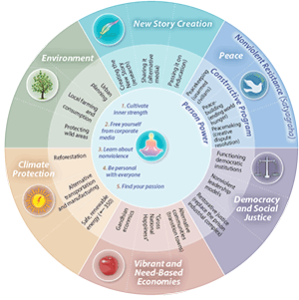About the Shanti Sena Network
Network Brief — Alternative Community Security: Initiatives and Stories
Examples of existing and potential initiatives toward comprehensive, systemic transformation of community protection. (Google Doc)
What is the Shanti Sena Network?
The Shanti Sena Network (SSN) comprises members from peace teams from around the US and Canada, and is open to members worldwide.
Passionate about building a new paradigm of security, members of SSN want to use nonviolent ways of resolving conflicts without the potentially violent intervention from “law enforcement” or the military. The Shanti Sena Network is grounded in the Gandhian principles of “unity in diversity” and holding a high image of human potential.
Shanti Sena means “peace team” in Sanskrit (see the formal definition in our glossary). A Shanti Sena is the nonviolent alternative to a violent “peacekeeping” system. More than just maintaining peace, a Shanti Sena aims to transform how we think about peace, envisioning a paradigm shift in the way we perceive human security. SSN reinforces a high image of the human being and holds space for parties in conflict to move into closer understanding and relationship of each other. A Shanti Sena is revolutionary because it refuses to maintain its legitimacy through violence, instead seeking ways of embodying a deep commitment to the practice of nonviolence.
See how unarmed peacekeeping shows us a way out of war in this short video from Nonviolent Peaceforce. (Read more about this video.)
Help Create a Peace Army
Feel called to contribute to the creation of a peace army, the nonviolent answer to security and conflict resolutions? Start here:
1. Learn everything you can about nonviolence. Our trio of short videos on nonviolence and peace teams make a great starting place.
2. Get a training in unarmed peacekeeping. Metta Center for Nonviolence is among several training organizations. Search for upcoming trainings at Nonviolence Training Hub.
3. Share stories and ideas from the world of unarmed peacekeeping with your friends and families. For nonviolent peacekeeping to take hold, society must be able to envision and believe that resolutions other than violence are possible in times of conflict. Spread the word!
4. Develop Shanti Sena Skills. Begin understanding what goes into peacemaking via podcasts, videos and writings from experienced SSN members, on our site.
Connect with Shanti Sena on Facebook.
Shanti Sena Network & Roadmap
On our strategy-based tool Roadmap, Shanti Sena Network would situate itself within the Peace wedge, at the level of Constructive Program.
Peace teams in the Shanti Sena Network provide training to those parties interested in learning nonviolent peacekeeping, and are also available to provide a nonviolent presence when violence is a possibility. It is also a network to help build a movement of domestic peace teams.
Q: What is a Shanti Sena”?
A: Shanti Sena means “peace team” in Sanskrit. A Shanti Sena is the nonviolent alternative to a violent “peacekeeping” system. More than just “maintain peace,” Shanti Sena aims to transform the way that we think about peace, envisioning a great paradigm shift in the way that we perceive human security.
It reinforces a high image of the human being and holds space for parties in conflict to move into closer understanding and relationship of each other. A Shanti Sena is revolutionary because it refuses to maintain its legitimacy through violence, instead seeking ways of embodying a deep commitment to the practice of nonviolence.
Peacemaking Resources
Evaluation Resources
Stories & Skills
- Shanti Sena Defined
- How DC Peace Team modeled community protection during election-related demonstrations
- Introduction to Nonviolence and Peace Teams
- Mark Shepard article on Shanti Sena during the Indian Liberation Movement
- Nonviolence Radio
U.S. Based Peace Teams
- MetaPeace Team (formerly Michigan Peace Team)
- DC Peace Team
-
Cure Violence (Public Health Approach: U.S. and International)
-
Presbyterian Peace Fellowship (U.S. and International)
- Water Protectors (U.S.)
- Washington Peace Team
- Portland Peace Team
- Bay Area Nonviolent Accompaniment Project (BARNAP) (Contact: janpassion1@gmail.com)
- Gandhi Team (San Jose, South Bay, CA)
- Erie Peace Team (Contact: Juan Llarena LLarena1@bellsouth.net)
- New York Peace Team (Contact: James Lynch, jameslynch795@gmail.com
- Norman Peace Team (Contact: normanpeaceteam@gmail.com)
- Chicago Peace Team (Contact: charles@chicagopeaceteam.org)
International Unarmed Protection Organizations
- Meta Peace Team
- Presbyterian Peace Fellowship (U.S. and International)
- Nonviolent Peaceforce
- Peace Brigades International
- Christian Peacemaker Teams
- Cure Violence (Public Health Approach: U.S. and International)
To join or get more information about the Shanti Sena Network, please contact Adele Lennig adele_lennig@outlook.com.
Readings for Further Study
Satyagraha (Non-violent Resistance), M.K. Gandhi
Gandhi’s Peace Army: The Shanti Sena and Unarmed Peacekeeping, Thomas Weber
A Nonviolent Revolutionary: Story of a Gandhian Educator, Narayan Desai
Towards a Nonviolent Revolution, by Narayan Desai
Handbook for Satyagrahis: A Manual for Volunteers of Total Revolution, Narayan Desai
Nonviolent Soldier of Islam, Eknath Easwaran
Search for a Nonviolent Future, Michael Nagler
Unarmed Bodyguards: International Accompaniment for the Protection of Human Rights, Mahony & Eguren
Becoming Nonviolent Peacemakers: A Virtue Ethic for Catholic Social Teaching and U.S. Policy, Wipf and Stock, 2012, Eli McCarthy
Witness for Peace, Ed Griffin-Nolan
Getting in the Way: Stories from Christian Peacemaker Teams, ed. Brown
Hebron Journal: Stories of Nonviolent Peacemaking, Gish
Civilian-Based Defense: A Post-Military Weapons System, Sharp
The Responsibility to Protect: Report of the International Commission on Intervention and State Sovereignty, ICISS
Nonviolent Direct Action: American Cases-Psychological Analyses, Hare & Blumberg
Liberation without Violence, Hare & Blumbert








